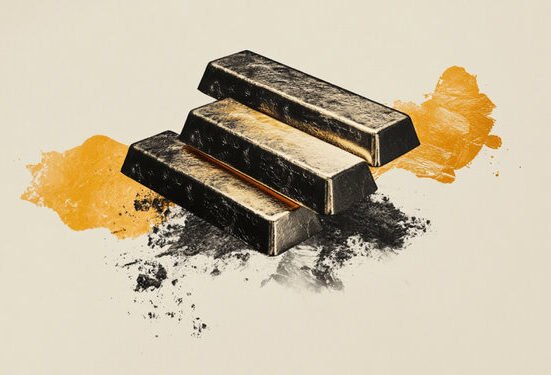By Myra P. Saefong
Silver missed a chance to outperform gold last month thanks to Trump’s tariff plans. Now it has another shot.
President Donald Trump’s April 2 tariff announcement didn’t just shake up global stock markets, it rattled the outlook for the economy and disrupted silver’s chance to outperform gold. Silver, however, may soon get another shot.
Late last month, gold and silver were trading virtually neck and neck in terms of year-to-date gains – with both up more than 14% for the year at the time. However, prices for silver have lost 5.4% from a month ago, while gold has climbed to fresh record highs, tacking on nearly 11% from a month ago, according to a Dow Jones Market Data analysis of FactSet data.
“For precious-metals fans, the split between gold and silver both signals the depths of recessionary fears and offers an opportunity,” said Adrian Ash, director of research at BullionVault. That’s because with silver now at less than 1/100th the price of gold, history suggests the “cheaper precious metal is badly undervalued right now.”
‘For precious-metals fans, the split between gold and silver both signals the depths of recessionary fears and offers an opportunity.’Adrian Ash, BullionVault
On April 2, U.S. President Donald Trump unveiled plans for a universal 10% tariff on all imported goods and even higher levies on many countries.
Ahead of that announcement, most commodities, including gold and silver, were trading higher as speculators expected the tariffs to prove inflationary, Ash said. But the “reality of Trump’s tariff war in fact looks way more deflationary, cursing global trade and economic growth.”
That would hurt demand for industrial inputs, including silver, while gold is “shining as an industrially useless safe haven – just as it did during the first-wave COVID crisis,” he said.
Trump later announced a 90-day pause on the new tariffs for most countries but slapped China with tariffs as high as 145%.
Economic sensitivity
Keep in mind that silver is “economically sensitive,” said Stefan Gleason, president and chief executive officer at Money Metals Exchange.
Concerns about the economic consequences of tariffs and lower international trade have weighed on the price of the metal, he said. Given silver’s heavy use in industry, including solar and electronics applications, an economic slowdown becomes a “headwind” for the metal.
Against this backdrop, gold has seen volatile trading, but with prices reaching never-before-seen heights as demand for the precious metal is dominated by “store-of-value investors,” said Christian Magoon, founder and chief executive offer of investment firm Amplify ETFs.
On Thursday, the front-month June contract for gold futures (GC00) (GCM25) settled at $3,328.40 an ounce on Comex after finishing at a record high Wednesday, while May silver (SI00) (SIK25) ended at $32.47 an ounce. With markets closed for Good Friday, both metals ended the week higher, but gold’s year-to-date rise of 26% far outpaces silver’s 11% climb for the period.
“Store-of-value demand tends to accelerate during times of investor uncertainty on market, fiscal, economic and geopolitical tensions,” Magoon told MarketWatch – and there’s currently a spike in all those factors, which is propelling gold to all-time highs.
Silver demand is powered “nearly equally by store-of-value and industrial demand,” he said. So while store-of-value demand is high, pushing up prices of silver in the year to date, its price also is affected by economic conditions on the industrial side.
‘Investors should focus on tariff and trade news related to electronic goods, electric vehicles, batteries and solar panels to understand silver’s industrial tells.’Christian Magoon, Amplify ETFs
On that note, “tariff drama, recession fears and general geopolitical tensions mixed together are created uncertainties for industrial demand conditions despite forecasts,” Magoon said.
As these uncertainties play out, “it could be a major propellant for silver to catch up with gold,” he said. “Investors should focus on tariff and trade news related to electronic goods, electric vehicles, batteries and solar panels to understand silver’s industrial tells.”
Here’s a sign of ‘extreme undervaluation’
Investors should also be looking at the high ratio between gold and silver prices, analysts said. At current price levels, it would take about 102 ounces of silver to buy one ounce of gold.
The ratio of more than 100 “presents a historically extreme undervaluation of silver versus gold,” said Money Metals Exchange’s Gleason, pointing out that the last time the ratio reached this level was in the early days of the pandemic panic. Prior to that, the 100-to-1 ratio was only reached briefly in the 1990s and during the Great Depression, he said.
BullionVault’s Ash said the last time silver traded this cheaply against gold, in May 2020, silver’s dollar price jumped more than 37% over the following six months, while gold rose by only 10% in dollar terms.
If today’s trade-war panic plays out like the COVID crash, silver is set to outperform gold three times over as economic sentiment rallies, he said.
In addition, a gold-to-silver ratio at 100-plus is “priced for a global economic recession,” said Ash, as it was in 2020.
“Whether or not a recession is coming, the ratio has moved so much higher so very quickly, the contrarian bet says the ratio will snap back,” he said. “If gold holds on to its recent move, that offers big upside in silver prices.”
Global supply of silver, meanwhile, has run at a deficit to demand for four years in a row, according to data from the Silver Institute.
In its latest World Silver Survey, the institute estimated total 2024 global silver supply at about 1.015 billion ounces, compared with total demand of about 1.164 billion ounces. For 2025, it forecast another inventory shortage, with supply at 1.031 billion ounces and demand at 1.148 billion ounces.
A ‘vastly better investment opportunity’
So despite gold’s continued rise to record highs, silver may emerge as a big winner for investors.
From a risk-versus-reward standpoint, “silver now presents a vastly better investment opportunity than even gold,” Gleason said. That’s “as long as one’s investment horizon is more than a few months.”
Whenever the gold-to-silver ratio reaches these extremely high levels, “investors who prioritize silver purchases over gold – or outright swap gold for silver – tend to be handsomely rewarded in the medium term as the ratio reverts to the mean,” he said.
In other words, the ratio eventually returns to its long-term average. Over the past 25 years, the mean has been about 70, and over the last 50 years, it has been in the low 50s, Gleason said.
The gold-to-silver ratio will generally fall sharply during the latter part of a bull market for gold, meaning that silver will “vastly outperform gold,” Gleason said. Since silver has not outperformed gold yet, that “suggests this bull market in gold is still quite young.”
If this bull market continues, as he expects, he believes silver will start to outperform gold “soon.”
At the last gold bull-market peak in 2011, the gold-to-silver ratio fell to 32. As an example, if the gold price rises to $5,000, that would imply a move in silver to roughly $150 an ounce, Gleason said.
“With a weakening dollar as a tailwind for both gold and silver, I still expect meaningfully higher prices this year,” he said.
Still, the risk to silver buyers in mid-2025 is that “unlike the COVID crisis, central banks don’t rush to rescue the economy or the financial markets,” according to BullionVault’s Ash. That’s the “real risk driving gold and hurting silver right now.”
-Myra P. Saefong
This content was created by MarketWatch, which is operated by Dow Jones & Co. MarketWatch is published independently from Dow Jones Newswires and The Wall Street Journal.
(END) Dow Jones Newswires
04-18-25 1154ET
Copyright (c) 2025 Dow Jones & Company, Inc.







